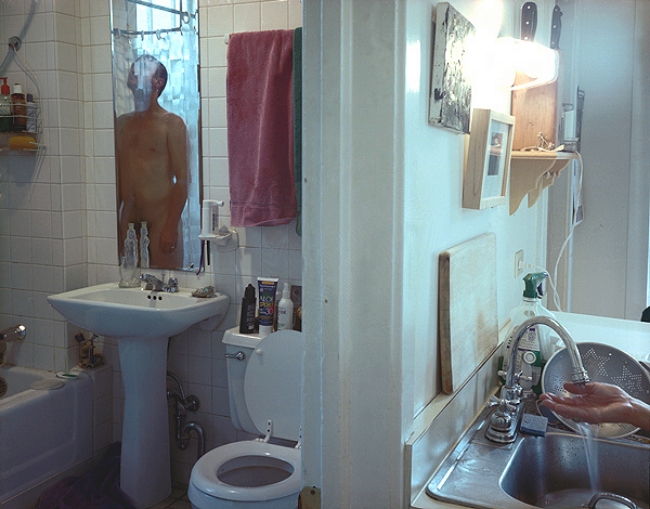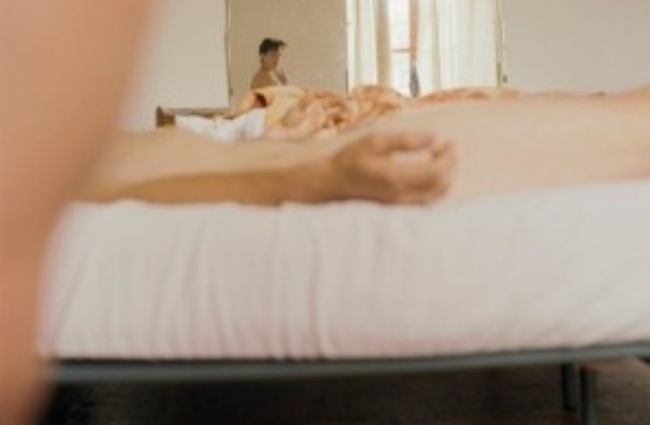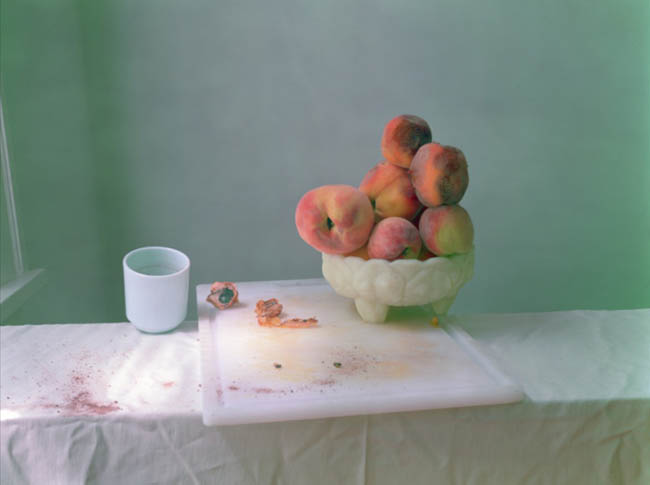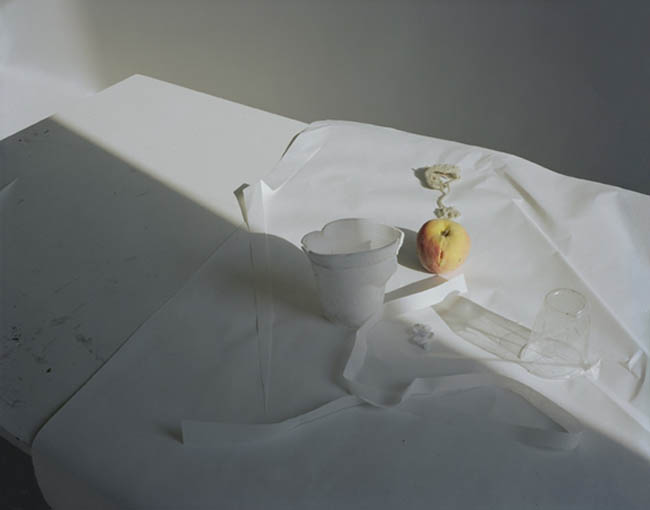Laura Letinsky became a photographer partly because the University of Manitoba in Winnipeg wouldn’t let her take a class in painting until she’d completed a prerequisite course in art fundamentals. There was no prerequisite for the photography class.
Letinsky began by emulating Diane Arbus. Perhaps it would be more accurate to say she began by copying Arbus. Like Arbus, she used a medium format camera with a strobe flash. She went to the places people gathered–fairs, festivals, carnivals, outdoor markets–and photographed the people she saw. She photographed them the way she thought Arbus would.
“I did horribly for the first part of the semester,” she told an interviewer. In fact, she did so poorly that she had to meet with her instructor. During that meeting, the instructor said something that “…made sense to me, something about making a picture versus taking a picture. I began thinking about the photograph differently.”

You’ll note she said she was thinking about “the photograph.” Not her photography, not photography in general. The photograph. Letinsky was thinking about the photograph as an object–the physical expression of a moment in time. “The photograph shows something that can no longer ever exist,” Letinsky says. The moment–even a controlled and posed moment–passes.
It should be clear by now that Letinsky is one of those thinking photographers. Even as a student, she was thinking. She eventually found herself in a graduate program in the School of Art at Yale.
“I started thinking about how I could make pictures about love. I was interested, for example, in the way pop songs say exactly what you want to say and feel completely individual and idiosyncratic, when of course they’re programmed and manipulated. What comes first–the feeling or the song? Do I feel this way because the song tells me to feel this way? Does popular culture inform how I feel? ”
The result of that sort of thinking was a series she called Venus Inferred.
Letinsky had abandoned her practice of photographing people in public places. For the next six years she photographed couples (including herself and her partner) in intimate settings, private settings, usually their homes. She wanted to explore the way the romantic expectations raised by popular shape private perceptions of love. The photographs depict moments that occur in the middle of a relationship–not the first passion, not the collapse of romance, but the period in which the couple come to understand that the promises of pop culture aren’t going to be realized.

The title of the series Venus Inferred is a pun on Sacher-Masoch’s 1870 novel Venus in Furs, which explores the idea of love as a power relationship. The novel became the basis for the term masochism. Letinsky seems to be suggesting that our willingness to believe in the promises about romantic life offered by pop culture is a sort of masochism. This series was shot in the early 1990s, a period in which the concept of the ‘male gaze’ was much examined. Letinsky deliberately made the female gaze one of the pivot points of the series.
As the series progressed, Letinsky gradually began to notice she was unconsciously shifting the people in the images away from the center of the frame and toward the edges. “I found myself wanting to empty the space out,” she said. Around this same time she also switched photographic formats, moving to a large format 4×5 camera. The physical size of the camera forced her to slow down; the larger negative allowed–perhaps required–her to pay closer attention to the compositional elements within the frame.
Letinsky was organically transitioning from situational portraiture to still life photography. Because she’s an analytical photographer, she began to think about still life imagery as a form, not merely as a genre of art. Her first attempts at still life work left her profoundly dissatisfied. “I kept choosing objects that seemed to have some kind of meaning and trying to make pictures of them, and they were just dumb.”
The still life tradition was crystallized in 17th century Europe. At that time there was a shared cultural understanding what the compositional elements meant. A lapdog meant fidelity. A burning candle, temporality. A pomegranate, fecundity. But today we have no commonly shared symbolic understanding. A rose is just a rose. In addition, 17th century still life paintings celebrated wealth; they depicted the things people owned. The things people had in their homes.

As her thinking became distilled, Letinsky began to create still life photographs that acknowledged their debt to the origins of still life work while turning the concept on its head. As always, it seems, the new direction of her work involved a great deal of thinking.
“I began to think about light differently, because in a lot of religious painting you often get two different lighting sources—a cool one and a warm one, or a golden glow.”
That attention to the use of light in religious painting became conflated with thoughts about modern culture.
“I was also thinking about the fact that we live in this culture that’s calling itself ‘post.’ We’ve got post-modernism, post-structuralism, post-capitalism, post-globalism, post-feminism. What does it mean to be “after” something?”
She worked with a subdued, muted color palette that emphasized the duality of the light and the colors of her subjects. With a nod toward classical still life, Letinsky began to photograph fruit. But where the classics celebrated affluence and abundance and the promise of future prosperity, her work depicted simplicity and the aftermath of abundance. Her fruit was beginning to mold. Her tablecloths were rumpled, the table surfaces strewn with the detritus of a celebration that had happened earlier and now was over.
She began to replace fruit with its modern equivalent–cake and candy. Letinsky reasoned the notion of fruit as ‘natural’ is no longer accurate. Fruit is essentially manufactured, artificially enhanced in taste and color, and only somewhat less industrial and contrived than candy. In the 17th century, exotic fruits became symbols of globalism and prosperity. As a culture, Letinsky seems to be saying, we are past fruit.

She also started to feature other aspects of modern culture. Where the classical still life might use a burning candle to represent temporality, Letinsky would turn her camera on modern examples of temporality: styrofoam cups and paper plates and plastic silverware. The classics intended the viewer to obtain a moral lesson from the fact that life and luxury are temporary. Letinsky may well be offering a moral lesson as well; these still life photographs depict a culture in which convenience trumps all. Plastic is anything but temporary.
In a way, all of Letinsky’s work to date seems to be about the tension of temporality and the aftermaths of gratification. The couples in her early photographs are adjusting to the reality that love is not a pop song. Her still lifes suggest that after every celebration, there’s always a mess to tidy up. And yet her work is in no way a complaint about those realities. They are simply an acknowledgment that they are realities, and perhaps a recognition that there is beauty in the moment. And if the moment passes–there is beauty in the next moment as well.
I suspect, though, that Laura Letinsky would find that last notion to be overly sentimental and sappy. She is, after all, a thinking photographer. She would probably remind me that the photograph is just the expression of a moment, not the moment itself. And she’d be correct. But even so, the expression is beautiful.
